

Wayne Schmidt's Smoke Ring and Air Blaster Gun Page How they work, reviews of two models, and how to build them.
The arrival of grandchildren quite naturally turned my mind back to the toys of my youth. One of those was the Wham-O Air Blaster, available in the mid-1960s.

This gun fired a puff of air that could disturb hair or knock over a house of cards from 20 feet away. It worked by a cocking mechanism, activated by a lever on top of the gun, pulling back on a rubber diaphragm at the base of the concave funnel on the front of the gun. When the trigger was pulled, the rubber diaphragm snapped forward, pushing a blast of air ahead of it. The cone concentrated and accelerated this blast. It really wasn't much of a toy but it looked like a ray gun and for a short period of time it was quite popular.
When I went looking for a contemporary version I was surprised to discover they weren't available, except as a expensive collector's item. It seems Wham-O ended up having to pull them from the market because if placed too close to an ear they could damage the ear drum. Also, too many kids were inserting potentially dangerous objects into the gun's muzzle to see how far they could be thrown.
What is available are much weaker air-puff guns which have been equipped with miniature fog generators so that the puffs of air, toroidal vortexes actually, can be seen. Although these don't have the power of the original Air Blaster, which wasn't much anyway, being able to watch the smoke rings emitted from them makes these newer guns much more entertaining.
I decided to purchase two of them to see how they worked and evaluate their entertainment value.

The gun on the left is the two-fisted Mighty Blaster and the one on the right is the Zero Blaster, both marketed by Zero Toys (www.zerotoys.com). Both have built-in fog generators and a bright blue LED that lights when the fog maker is triggered.
The Mighty Blaster makes 4-inch diameter smoke rings that can travel as far as 20 feet.
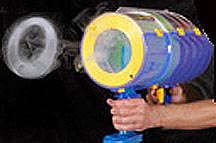
There are two power settings that control the speed and power of the air blast ejected from the gun. The low power setting is best for generating high-quality smoke rings that travel a long distance. The high power tends to blow the rings apart and is more useful for ruffling someone's hair from across a room. (Actually, the toroidal vortex emitted drifts left, right, up and down so much that hitting what you aim at is strictly a matter of chance.)
The Mighty Blaster can also be operated by reaching inside the gun and manually pulling back and releasing the diaphragm that pushes the air out of the gun. Pushing the diaphragm forward slowly creates slow moving 6-inch diameter smoke rings. Pulling the diaphragm back only 1 inch and letting it go produces very fast moving rings that are only 2-inches in diameter. I found the sharpest shaped, longest lasting smoke rings are produced by pulling the diaphragm back 2 inches and releasing it.
Downsides: Many. The Mighty Blaster required assembly and several of the steps were difficult to do. Additionally, the Wizard Stick fog machine that came with my unit had a touchy heater switch that only works 50-percent of the time. The fog generator uses up a lot of fog juice and needs to be refilled often. You have to wait after each firing to give the fog generator enough time to refill the chamber. Because the chamber is so large this can take some time. The power adjustment is set by snapping on or removing a plastic spacer on the back of the diaphragm. It's a bit of a hassle. The size of the gun is such that young children may have problems using it.
Although we live in a "bigger is better" society, I found the smaller Zero Blaster to be much more interesting and fun.
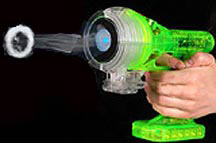
The smoke rings it ejects are only 2-inches in diameter but tend to be more sharply defined than the larger ones from the Mighty Blaster. Better still, the Zero Blaster only needs one hand to operate. The Mighty Blaster has to be recocked after each firing, the Zero Blaster uses a double action trigger that cocks and fires in one motion. You can fire off dozens of smoke rings as fast as you can twitch your finger.
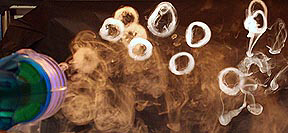
Downsides: None. The gun comes completely assembled and is robust enough to withstand considerable abuse. It's so easy to use that my two-year old grandson could fire it. It uses very little fog juice and one filling was enough to make over 100 smoke rings. In fact, once the chamber is filled, which the fog generator does very quickly, the gun can be fired repeatedly in rapid succession to produce a dozen or more smoke rings even if the fog generator is left off. The gun has four different power settings, which are easily and quickly adjusted by a lever on the back of the gun.
Final Evaluation: The Zero Blaster is a great toy that holds the attention of both the youngest and grown-up children like myself. The smoke rings from either gun are seen best if they have a dark background and are brightly lit from the side. Another way to maximize their visibility is to fire the gun in one hand while the other shines a powerful, focusable flashlight (like a 5-cell Maglite) on the smoke rings as they drift away. The Mighty Blaster looks and is more powerful but small children will have a hard time using it. It's not as much fun as the Zero Blaster, as both my 2-year old and 3-year old grandsons will testify.
Build
your own!
Smoke ring generators are easy to make from free materials that can be found in any home. The following picture is of one made out of an oatmeal box:

I cut a 2-inch diameter hole in the cardboard bottom of the box for the smoke rings to come out. Cutting the center out of the plastic lid created a ring which held a loose piece of plastic from a baggy over the opposite end. A piece of tape in the middle of the plastic provides a simple handle. Fill the box with fog, either from a fog machine or by placing a few pieces of dry ice inside it, rapidly push in the plastic diaphragm and out pops a smoke ring.
Smoke ring generators can be made any size, as the following picture shows:
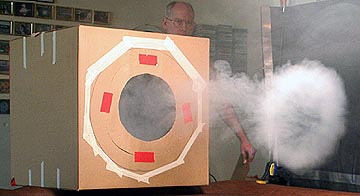
The cardboard box this giant was made from measures 28-inch on a side. The hole is 16-inches in diameter and creates smoke rings that are well over a foot across. Its construction is identical to the oatmeal box smoke ring generator. I've seen pictures of 8-foot diameter models that make smoke rings 5-feet across.
After experimenting with several designs and researching many more in the Internet, I've noticed that the diameter of the hole is usually about half the diameter of the chamber. When I try cutting the hole much larger than this the smoke rings tend to be poorly formed and short-lived.
Whether you buy or build your smoke ring generator, remember that they only work where the air is very still.
Time
for a little science:
All of these guns are classed as "vortex generators" because the puff of air emitted from them is a toroidal vortex, a donut-shaped rotating ring.
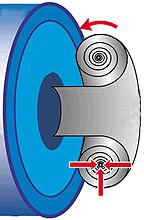
As the diaphragm pushes the air out of the gun, aerodynamic drag from the edge of the ring that makes the front of the gun and the still air outside of the gun causes the exhausted air to begin rotating as the red arrow at the top of the drawing shows. This creates the toroidal vortex. Because it's rotating, the velocity inside the vortex is greater than the velocity of the air outside it (Actually, the velocity of the air outside the vortex is zero because it's still). Bernoulli's law states that the faster a flow of air is moving the lower its pressure. Since the air inside the torus is moving and the air outside isn't, that means that the pressure inside the torus is lower than the outside. This inward pressure, as indicated by the three red arrows on the bottom of the drawing, is the force that holds the smoke ring together.
The really interesting thing about smoke rings is that they don't push their way through the air as you might expect. Take a second look at the rotational arrow at the top of the drawing. That's the direction the air in the vortex is moving: backwards on the outer surface of the ring. As this flow rubs against the still air that surrounds the torus, friction causes the torus to tractor itself forward. Imagine a chain saw with its blade pushed against the ground, it would tend to pull itself forward. Same idea.
What keeps the smoke ring moving and why does it eventually stop? The energy that is used to move it forward and keeps the vortex rotating is taken from the inertia of the rotating air in the vortex. Inertia is the tendency of anything in motion to keep moving. (Ignoring this principle is why there are multi-car pile-ups when people tailgate. The cars keep going in spite of the fact the brakes are slammed on.) Even though we can't see it, feel it, or taste it, air has weight and therefore once it's in motion it has inertia that'll tend to keep it in motion. The spinning of the air in the torus is where the energy that keeps the torus moving is stored. Eventually, air friction eats away all the energy stored in the vortex and the smoke ring drifts to a stop.
What
is the smoke given off by the guns?
It isn't really smoke; it's a fog: a cloud of microscopic droplets so small that they float in the air.
To understand why the smoke (fog) from these guns (or larger fog machines for that matter) hangs in the air for a long time like smoke, we have to make some tea.
Imagine a teapot. Inside, as the water vaporizes it becomes water vapor (steam): individual free molecules of water. When the steam leaves the pot it mixes with the cool air outside it and the water vapor condenses into microscopic droplets. These tiny balls of water act like lenses, reflecting and refracting light so that they appear like a white cloud. Within a second or two, unless you are in an extremely humid location, the individual droplets of water evaporate and disappear.
That's the same way a fog generator works. It has a heating elements that vaporizes a liquid which then condenses into droplets we can see because they reflect light. The only difference between a fog generator and a teapot is the liquid used in them.
Fog generators use a non-toxic mixture of propylene glycol, trifthylene glycol and water. This mixture boils at a higher temperature than water. The two glycols slow the rate of evaporation of the individual droplets that make the fog so it lasts much longer than simple water fog. They also change the refractive index of the droplets so that they appear brighter, making the fog look thicker. Different companies use slightly different mixtures for their fog juice and for this reason it is always important to use only that company's fog juice in its machines. Failure to do so could result in a low-temperature fog juice being used in a high-temperature machine, with the result that the juice starts burning and emitting dangerous compounds.
While some companies offer scented fog juices, there is no way to create colored fog. Adding food color to the fog juice doesn't work and can burn on the heating element.
Unless you live in a very hot location, the fog from a fog machine will always rise because it's warm and warm air rises. There are no special mixtures of fog juices that create a "heavy" fog that clings to the ground. The only way to do that is to run the output of a fog machine through a box lined with dry ice to cool it, or simply use dry ice itself to create a cooler fog.
How
about dry-ice fog?
The fog produced by dry ice consists of water vapor condensed out of the air by the low temperature of the dry ice. The same thing can be seen with regular ice, though its higher temperature is only able to create the lightest wisps of fog close to its surface. The fog created by dry ice stays around longer than that from a teapot because it's cool and therefore evaporates much slower.
Great quantities of dry ice fog can be generated for a short period of time by dropping crushed dry ice into a bucket filled with hot water. For example:

This is 30-pounds of dry ice hitting 10-gallons of boiling water. The fog from this may feel warm, but it still tends to remain close to the ground because it is so dense and it's still cooler than the fog given off by fog machines.
(Note: if you use dry ice to create a fog in a very cold place like Alaska in winter, the cold air will be denser than the fog and like the output from a fog machine, it will rise.)
And
finally, let's get a little weird... square smoke rings?
At first this sounds impossible because most of our experience with naturally occurring round things, like bubbles, can only exist in the round form. But, that's because their structure is dominated by surface tension forces. Smoke rings don't have this limitation so I decided to try making a square smoke ring to see what happens. It worked... sort of.
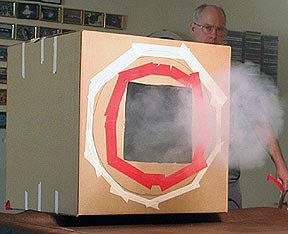
While the cloud coming out of the square hole appears round, what the camera couldn't capture in this single image is that rather than being round (or square, to be honest) the ring had a wiggly look that bounced between being a square and a diamond as it moved through the air. I believe what's happening is that the vortex wants to be circular so it pulls the corners of the square in. But, once the corners get moving they have inertia and keep moving past the position of the ideal ring shape and carry over inward, creating a diamond shape. The vortex doesn't like this either so it draws the ring sections that are inside the desired ring diameter outward. Again, they overshoot and the ring bounces back to a square shape. This oscillation is difficult to see unless the ring has a very clean, shape shape.
Even
weirder: inverse smoke rings!
While the following effect is hard to see, it may be of interest to some people. A smoke ring is a torus of smoke flowing through clear air. In theory it should be possible to create and see an inverse smoke ring by blowing a torus of clear air through air filled with smoke. To try this I used a smoke machine to fill my gargage with a thick cloud of fog, then fired my Airzooka (please see review below), making sure that the Airzooka's chamber hadn't been filled with fog.
It worked! Although I didn't manage to capture it on film, I could clearly see a zone of clear air traveling through the fog. It was less defined than a smoke ring, but an interesting experiment just the same.
Last
stop: an air canon
Thinking that the power of the original Wham-O Air Blaster came from the conical nose that concentrated the blast of air emitted from the gun, I taped a cone to the front of my Mighty Blaster.
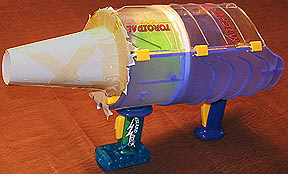
It didn't work. The compression created by the cone created enough backpressure to slow the movement of the diaphram. If anything this modification reduced the power of the blast. It would seem that what's needed is a gun that uses a drive mechanism similar to the original.
AIRZOOKA UPDATE!!!
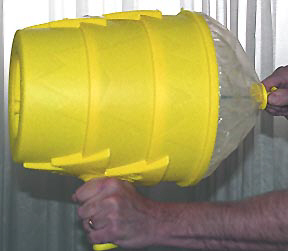
The Airzooka appears to be a poor brother of the Mighty Blaster. Appearances are deceivng. While its construction is simplier, its decoration less gaudy and it doesn't have an integrated fog machine, the Airzooka delivers what Mighty Blasters can only dream of: power!
The Airzooka packs an aerodynamic punch that puts even the original Wham-O Air Blaster to shame. Although the Airzooka is only advertised as projecting a blast of air 20 feet, I found mine can easily send a powerfull enough blast to punch drapes 40-feet away. At 20 feet the impact of the air blast against a wall is loud enough to hear. At 15-feet it's loud enough to make a pronounced and satifying "wump" when it hits. I've blown over a house of cards at 50-feet under ideal conditions. Loaded with fog from dry ice or a fog machine this gun also shoots perfectly-shaped smoke rings if the diaphram is only pulled back 2-inches and released. Pulling it back any further creates so much turbulance as a result of the speed and power of the blast that the smoke ring's shape is blown away.
The Airzooka works by using elastic bands to pull a clear plastic membrane forward after you use your other hand to pull it back. The combined effect of the speed of the diaphram being greater than the Mighty Blaster and the fact that it goes from a concave to a convex shape as oppossed to the Mighty-Blaster's flat diaphram seems to be the reason the Airzooka produces a more powerful blast. How much more powerful? The Airzooka can do at 40 feet as much as the Mighty Blaster at 8 feet.
The Airzooka snaps together fairly easily and only cost $10.00 at Walmart in 2006. They are also available on-line.
One word of caution: like the original Wham-O Air Blaster, the Airzooka generates so much power that firing it at someone at close range may cause ear damage or blow particles at dangerous velocities into their eyes.
Return to homepage to browse 100 other topics: everything from metal detectors and Knitting Nancies to the strange world of lucid dreaming.